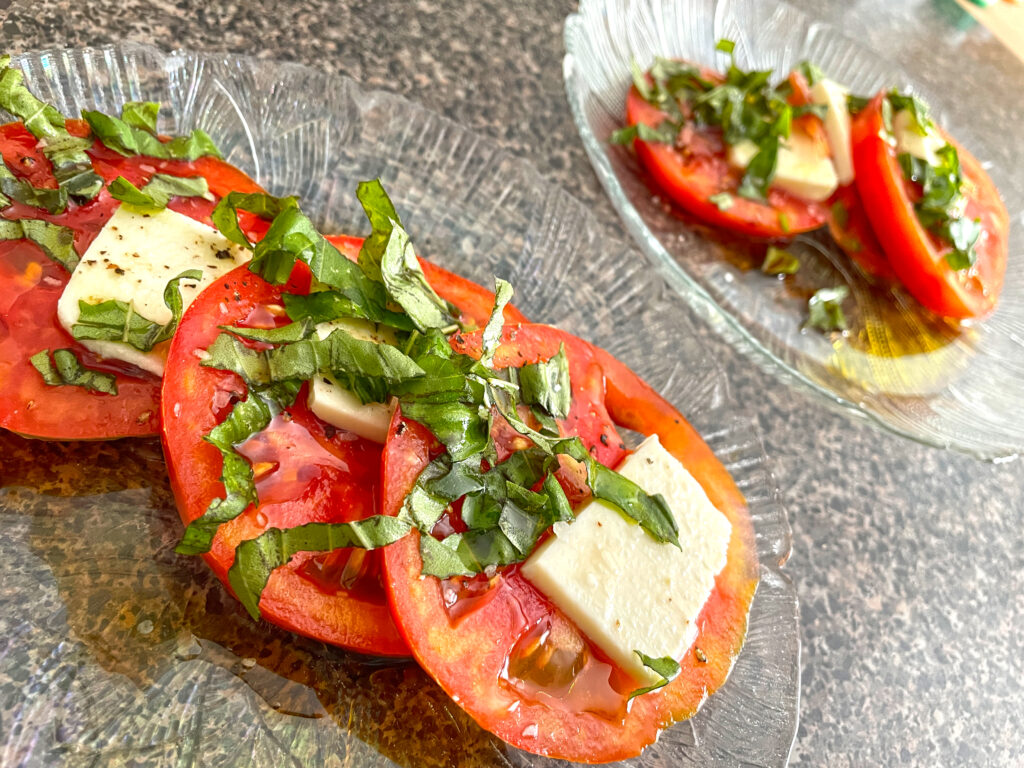We did not have any fresh mozzarella on hand, but we did have some queso fresco cheese left from another recipe, and with our ripe from the vine Creole tomatoes and fresh basil from the garden, I created this wonderful salad. While queso fresco is not mozzarella, the cheese provided a great substitute for a wonderful salad, and a perfect marriage of Mexican and Italian cuisine.
Mexican and Italian cuisines are beloved for their bold flavors and vibrant ingredients. Combining the two culinary traditions results in a tantalizing fusion that will delight your taste buds. In this blog post, we present a recipe that brings together the best of both worlds—a mouthwatering mashup of Mexican and Italian flavors. Get ready to savor the harmony of spices, herbs, and fresh ingredients with a twist on the classic Caprese Salad, featuring the creamy goodness of Queso Fresco. Let’s dive into this delectable fusion feast!
The Recipe: Queso fresco caprese salad
Serves: 2
Ingredients
- 1 ripe tomato
- 1 ounce Queso Fresco cheese, sliced into 6 thin pieces
- Handful of fresh basil leaves, cut into a chiffonade
- 1 tablespoon extra virgin olive oil
- 1 tablespoons balsamic vinegar
- Kosher salt and fresh cracked black pepper to taste
Procedure Steps
- Cut the tomato into 6 even slices and plate three slices evenly between two plates. Add the sliced cheese between the tomato slices. Sprinkle the basil chiffonade evenly over the tomatoes and cheese between the two plates.
- Drizzle 1/2 tablespoon olive oil and 1/2 tablespoon balsamic vinegar evenly over each plate of tomatoes and cheese.
- Season to taste with the salt and pepper.
Queso Fresco background and history
Queso Fresco, which translates to “fresh cheese” in Spanish, has a rich history and is a popular cheese in many Latin American countries, particularly Mexico. The origins of Queso Fresco can be traced back to the indigenous civilizations of Mesoamerica, including the Aztecs and Mayans, who were known for their advanced agricultural practices and culinary traditions.
The process of making Queso Fresco involves coagulating milk with rennet or an acid, such as lemon juice or vinegar, and then allowing it to drain, resulting in a fresh, crumbly, and slightly tangy cheese. Queso Fresco is commonly made from cow’s milk but can also be made from goat’s or sheep’s milk, depending on regional preferences.
Queso Fresco is a versatile cheese that is widely used in Mexican cuisine. It adds a creamy texture and a subtle, milky flavor to dishes. It is often crumbled over tacos, enchiladas, and salads, and is also used as a filling for empanadas and other savory pastries. Its mild flavor pairs well with the bold spices and ingredients commonly found in Mexican cooking.
Caprese Salad background and history
Caprese Salad is a classic Italian dish that originated in the region of Campania, specifically on the island of Capri. It is a simple yet elegant salad that celebrates the flavors of fresh, ripe tomatoes, mozzarella cheese, and basil leaves. The salad is typically drizzled with extra virgin olive oil and seasoned with salt and pepper.
The origins of Caprese Salad can be traced back to the 1950s when it was popularized as a staple dish in Italian cuisine. Its creation is often attributed to the chef and restaurateur, Filippo Tommaso Marinetti, who sought to showcase the flavors of the Mediterranean region through his culinary creations.
Caprese Salad embodies the essence of Italian cuisine, emphasizing the use of high-quality, seasonal ingredients. The combination of tomatoes, mozzarella, and basil represents the colors of the Italian flag, further adding to its cultural significance.
Cultural Influences: The cultural influences of Queso Fresco and Caprese Salad extend beyond their countries of origin. Both have gained popularity worldwide and have been incorporated into various cuisines, reflecting the global appreciation for their distinct flavors and versatility.
In the case of Queso Fresco, its influence can be seen in the cuisines of other Latin American countries, such as Colombia, Venezuela, and Nicaragua, where similar fresh cheeses are widely used. Queso Fresco has also made its way into Tex-Mex and Mexican-inspired dishes in the United States.
Caprese Salad, on the other hand, has become a beloved dish in many parts of the world, particularly in Mediterranean and European cuisines. Its simplicity and use of fresh ingredients have made it a staple in Italian restaurants and households globally. Additionally, variations of Caprese Salad have emerged, incorporating additional ingredients like balsamic glaze, avocado, or prosciutto, further expanding its culinary influence.
The cultural influences of Queso Fresco and Caprese Salad highlight the power of food to transcend borders and bring people together through shared flavors and appreciation for culinary traditions.













